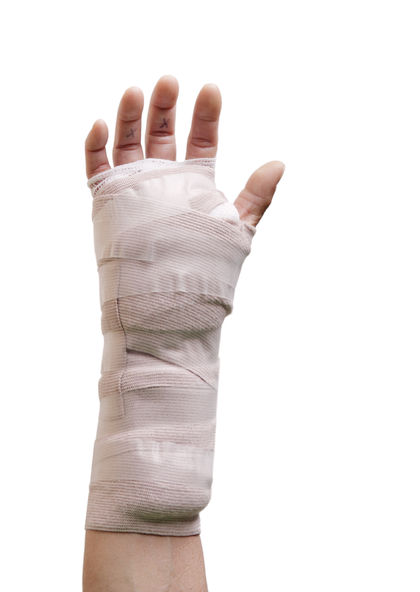Leprosy

Leprosy (LEH-pro-see) is a chronic * , infectious disease that damages the skin, peripheral nerves * , and mucous membranes * of the mouth, throat, and eyes. Leprosy also is known as Hansen disease.
KEYWORDS
for searching the Internet and other reference sources
Hansen disease
Lepromatous
Multibacillary Hansen disease
Mycobocterium leprae
Paucibacillary Hansen disease
Tuberculoid leprosy
What Is Leprosy?
His equipment was inadequate and his colleagues thought his theories were laughable. Still, Gerhard Henrik Armauer Hansen (1841-1912) spent day after day bent over his microscope, determined to prove that leprosy was caused by bacteria. And he did. In 1873 the Norwegian physician identified the rod-shaped bacterium Mycobacterium leprae (my-ko-bak-TEER-e-um LEH-pray) as the cause of the illness. Hansen's discovery was immensely valuable in the treatment of leprosy, and it was a scientific milestone—the first proof that bacteria could cause human disease. Today, the use of the word "leper" is considered insulting, because it defines a person by the disease he or she has. Many advocates for people with leprosy prefer to call it Hansen disease.
* chronic (KRAH-nik) means continuing for a long period of time.
* peripheral (puh-RIH-fer-ul) nerves are a network of nerve fibers throughout the body that send and receive messages to and from the central nervous system (the brain and spinal cord).
* mucous membranes are the moist linings of the mouth, nose, eyes, and throat.
3,000 Years of Leprosy
Leprosy has left a trail of pain, suffering, and death that dates back thousands of years. Archeologists have uncovered skeletal remains with erosion in the bones of the nose that is characteristic of leprosy. Researchers translating from ancient Indian and Chinese texts have found descriptions of the disease. As men and armies roamed the globe in search of conquest, the germ that causes leprosy traveled with them. Researchers believe that in the first century B.C., Roman soldiers fighting in Egypt carried the disease home to Italy. In the Middle Ages, the disease spread from Italy throughout Europe. During the Crusades, a series of "holy wars" spanning the eleventh to the thirteenth centuries, European soldiers and pilgrims carried the disease as far as Jerusalem in the Middle East. The disease continued to follow the paths of conquering armies. The Spanish conquistadors and the slave trade brought the disease to the American continents, and European colonists probably spread the disease to islands in the Pacific Ocean.
The name paucibacillary (paw-sih-BAH-sih-lair-e) Hansen disease comes from the Latin word pauci, meaning few, and is used to describe a mild form of leprosy. Paucibacillary Hansen disease begins in the peripheral nerves and spreads to the skin, causing patches of skin to become numb and hypopigmented, which means that the skin has lost its coloring and appears white. Multibacillary (mul-tie-BAH-sih-lair-e) Hansen disease is a more severe form of the disease. Multibacillary Hansen disease also causes skin lesions (LEE-zhuns), or patches of damaged tissue; nodules, or lumps; and thickening of the skin. Without treatment, this type of leprosy can worsen over time, resulting in severe skin and tissue damage and disfigurement.
How Common Is Leprosy?
Throughout human history leprosy has caused untold suffering. Even after Hansen's groundbreaking discovery, the disease remained unchecked in many parts of the world. In 1991, the World Health Organization (WHEO) began a global campaign to reduce the number of cases of leprosy. A decade later the organization announced that it had reached its goal and estimated that there were at that time 600,000 to 750,000 cases of leprosy worldwide. The disease is most common in tropical and subtropical regions, and in 2001, it remained a particular problem in Brazil, India, Madagascar, Mozambique, Nepal, and Myanmar. Leprosy is most common in densely populated areas with poor sanitation and health care, and children are at greater risk than adults of getting the disease. In the United States about 100 cases are reported each year, many of them in people who have recently immigrated.
Is the Disease Contagious?
Leprosy is contagious but does not spread easily. Researchers believe that Mycobacterium leprae is transmitted from person to person via respiratory droplets, bits of moisture that leave the mouth or nose when a person laughs, talks, sneezes, or coughs. Most people seem to have a natural immunity * that enables them to resist the disease. Of those in whom leprosy is diagnosed, most have had prolonged and close contact with someone who has an active infection. Once a person with leprosy has been taking medication for 3 or 4 days, the disease is no longer active or contagious.
What Are the Signs and Symptoms?
Leprosy begins as an infection in the nerve endings and spreads gradually; the skin near the infected nerves may become numb and hypopigmented. In severe cases, these skin lesions become wider and thicker. The muscles in the hands and feet can become weak or paralyzed (unable to move) because of damage to the peripheral nerves. That loss of sensation can lead to accidental injury, because a person loses the withdrawal reflex that helps protect against injury from hot or sharp objects. Left unchecked, the most severe form of the disease can progress, producing large, disfiguring nodules and enlarged facial features that give a person the lionlike appearance associated with severe leprosy.
* immunity (ih-MYOON-uh-tee) is the condition of being protected against an infectious disease. Immunity often develops after a germ is introduced to the body. One type of immunity occurs when the body makes special protein molecules called antibodies to fight the disease-causing germ. The next time that germ enters the body, the antibodies quickly attack it, usually preventing the germ from causing disease.
How Is Leprosy Diagnosed?
Leprosy is not difficult to diagnose once it is suspected. A procedure in which a tiny piece of skin is scraped or cut away and then examined usually reveals the presence of Mycobacterium leprae in the multibacillary form of leprosy. (The bacteria may not be found using this method in milder, paucibacillary disease.) The procedure can be done quickly and relatively painlessly in a doctor's office or clinic. It is an important part

Can Leprosy Be Treated?
Early diagnosis and treatment are key to stopping the spread of leprosy to other people and preventing long-term damage to the patient. Doctors most often prescribe multidrug therapy (MDT), combining two or three drugs that kill the bacteria: dapsone (DAP-sone), rifampicin (rye-FAM-pih-sin), and clofazimine (klo-FAY-zuh-meen). The MDT approach has been preferred since the early 1980s, when researchers noticed that the bacterium was becoming resistant to some treatments. Patients may take the drugs for as little as 6 months or as long as 2 years. Patients who have become disfigured or who experience disabilities may need surgery to correct these problems.
* neurocutaneous (nur-o-kyoo-TAY-nee-us) means affecting the skin and nerves.
What Are the Complications and Course of Leprosy?
With MDT, paucibacillary Hansen disease can be cured within 6 to 12 months and multibacillary Hansen disease within 2 years. Untreated, leprosy can cause blindness, permanent nerve damage, and deformity. People may lose the use of their hands or feet, because, over time, the decreased sensation may result in repeated injuries to the limbs.
How Can Leprosy Be Prevented?
Despite centuries in which people with leprosy were vilified, shunned, and even isolated in far-off "leper colonies," there is no need to separate people with leprosy from the rest of society to avoid the spread of infection. MDT treatment is more effective and far more humane, and it has been determined that leprosy is much less contagious than once was believed. Hand washing, disinfection, and monitoring of close contacts are recommended to help prevent the spread of the disease.
See also
Public Health
Resources
Book
Eynikel, Hilde. Molokai: The Story of Father Damien. Translated by Lesley Gilbert. New York: Alba House, 1999. This is the story of the Belgian priest who cared for thousands of people with leprosy who were banished to the remote island of Molokai in the Hawaiian Islands. The book was made into a movie by the same name that is available on DVD.
Organization
World Health Organization (WHO), Avenue Appia 20, 1211 Geneva 27,
Switzerland. The WHO tracks efforts to eradicate leprosy and has links
to fact sheets and information on the prevention and control of the
disease on its website.
Telephone 011-41-22-791-2111
http://www.who.int
Comment about this article, ask questions, or add new information about this topic: